~ CREATIVE SOAPMAKING ~
December
Wood Soaps
Soap Gifts
Shaving Soap
Home Fragrancing

Contents
Wood Scents in Soapmaking—Why?
Evergreen and Other Tree Essential Oils
Sandalwood EO vs. FO—Is the Difference Worth the Cost?
Basic Wood Soap and Variations
Soaps from the Past—Pine Tar Soap
Easy Pine Tar Soap
What Would I Do?
Fragrances and Essential Oils for Gift Soaps
Holiday Fragrance Oils
Gift Soap in a Hurry
Packaging Soaps for Gifts
Giving a Soapmaking Lesson
Shaving Soap
Home Fragrancing
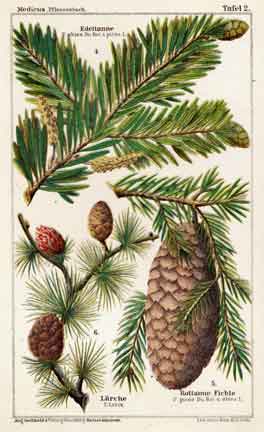
Wood Scents in Soapmaking—Why?
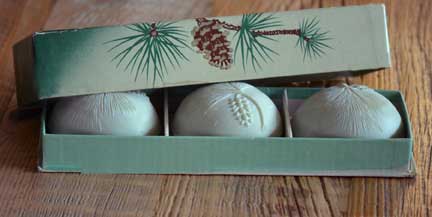
An Avon soap from the 1950s. With its mild evergreen fragrance, it was marketed as a gift for men.
Wood scents and other wood ingredients have a long history in the perfumer's and soapmaker's repertoire. Wood scents such as pine and fir have long been popular with men, especially in the days when a more "perfumed" kind of soap might have been unacceptable to many of them. Sandalwood is a classic favorite of both men and women.
The old-fashioned pine tar soap has been used for many years for cleansing and deodorizing, and is believed by some to be helpful for certain skin conditions. (However, if you sell pine tar soap, do not make medical claims for it!)
Evergreen fragrances are also a staple of holiday home fragrancing and gift items.
Evergreen and Other Tree Essential Oils
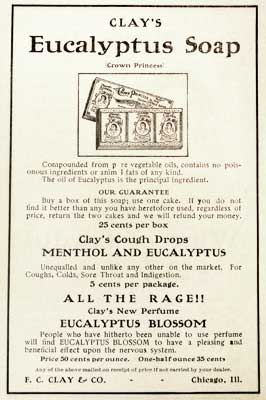
Here are some of the "woody" essential oils you can use in soap.
Juniper Berry—Fresh, clean, and somewhat spicy. The essential oil itself didn't seem to me to have a typical "Christmas tree" scent, but once I soaped it, it did. Does not accelerate trace.
Fir Needle—"Christmas tree" scent. It's sometimes reported to accelerate trace, but in my experiments, it didn't.
Balsam Peru—The scent is sweet, but medicinal. Probably better as a blending scent than for solo use. Definitely not a holiday evergreen scent.
Bay Leaf—Smells exactly like culinary bay leaf. This essential oil is a very strong trace accelerant, and few vendors say so. See August for suggestions for working with accelerants.
Eucalyptus—This is a "spa soap" smell, clean but not sweet. May remind some people of cold remedies. It does not accelerate trace.
Cedar Wood—A fresh, somewhat sweet scent, quite unlike the "cedar closet" odor I was expecting. Would blend well with orange. Does not accelerate.
White Birch—Said to have medicinal properties. It wasn't available from the soapmaking supply vendors I checked, so I wasn't able to test it. I've read that it accelerates trace.
Rosewood—Not recommended for environmental reasons, and may be an irritant as well.
Pine—Best used in combination with other scents. By itself, pine may be too much like the odor of commercial cleaners.
Sandalwood EO vs. FO—Is the Difference Worth the Cost?
Sandalwood essential oil is very, very expensive. So expensive that putting it into soap is probably out of the question. Fragrance oils are available, and some are advertised to be close to the real thing.
I bought a very small amount of sandalwood essential oil and several sandalwood fragrance oils. I liked the fragrance oils—they were good quality, and about what I expected in a sandalwood fragrance. So, I was hoping to be able to report that sandalwood essential oil is not sufficiently better to be worth considering.
However, now that I've tried both, I can't say that. The essential oil was far superior to the fragrance oil. There was almost no comparison. In addition to the expected scent, the essential oil had a fresh-cut wood note, almost a green aroma. It was amazing.
I would still not put sandalwood essential oil into soap. The fresh scent might be lost, and the cost would be staggering. I'm thinking it might work well in a very small quantity of solid perfume. Or at my wildest extravagance, in one bottle of lotion.
Basic Wood Soap and Variations
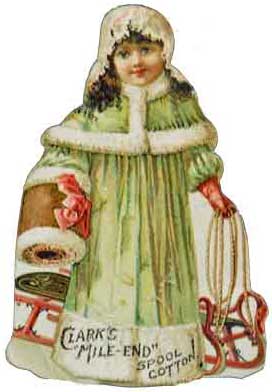
All the fats in this recipe are easily available from most grocery stores. Sugar will increase lather, but it's not necessary. If you use it, dissolve it in the water before adding the lye.
21 ounces (595 grams) grapeseed oil
9 ounces (255 grams) coconut oil
2 ounces (56 grams) fragrance oil or essential oil, or per vendor's recommendation
9 ounces (255 grams) water
2 teaspoons sugar, optional
4.1 ounces (117 grams) lye
Variations—Substitute milk, cream, yogurt mixed 50-50 with distilled water, flattened beer, or orange juice for the water. Any of these should be frozen in cubes before being combined with lye.
Soaps from the Past—Pine Tar Soap
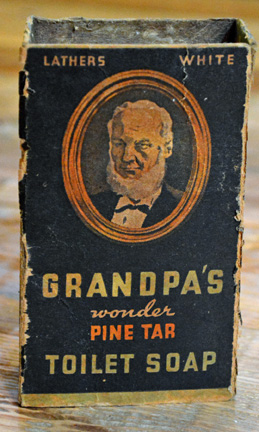
Pine tar is used in many industries, including wood preservation, veterinary care, and the rubber industry as a solvent. Pine tar soap has been made for over a century and is still available today. I often get requests for recipes for it. It is said to be effective for some skin ailments, although the US Food and Drug Administration does not acknowledge it as medically effective.
Pine tar soap has a reputation for being difficult. This is because pine tar is a fairly strong trace accelerant. Reports are common of "soap on a stick" and having to cram the fast-solidifying stuff into molds.
Unscented, the soap does not smell like pine, or like tar. I can only describe it as "medicinal," maybe slightly metallic. If it's not to your taste, you may like it better if you add fir needle EO or other evergreen scent. Pine tar has a strong scent to overcome, so consult your fragrance vendor for upper limit amounts of FO or EO to add.
The soap is brown, but the lather is white.
Easy Pine Tar Soap

Pine tar soap is quite easy with this recipe. The selection of fats is designed to be chemically "slow," the low temperature helps keep the soap from accelerating, the recipe contains a little more water than usual, and the soap is already in the mold when you add the pine tar.
Pine tar is messy, so as much as possible, use cups, spoons, and other utensils that are disposable. I covered my work counter with newspaper to minimize cleanup.
You'll need a silicone loaf pan to make this. It should hold over a quart. The soap is about a quart of liquid, but you need extra space for stirring. Put the soap on a tray or other flat, solid surface before you begin. It's best if this "trivet" has a raised edge in case some of the soap spills over while you're stirring. The pan may retain the smell of pine tar and not be usable for other soaps—I used one I found at a thrift store.
7.2 ounces (204 grams) lard
9 ounces (255 grams) coconut oil
6 ounces (170 grams) almond oil
6 ounces (170 grams) olive oil
10.2 ounces (289 grams) water
1 tablespoon sugar
Optional fragrance (See note below.)
4.1 ounces (118 grams) lye
1.8 ounces (51 grams) creosote-free liquid pine tar
1. Dissolve the sugar in the water. Freeze in cubes.
2. Melt the lard and coconut oil together. Add the almond oil and olive oil.
3. Add the lye to the frozen sugar water. When the ice is melted and the lye is completely dissolved, add to the oil mixture.
4. Stick blend to very light trace. Pour into the mold.
5. Quickly stir the pine tar into the soap in the mold. Thoroughly work it into the corners and edges, stirring until well mixed. By this time the soap will be at heavy trace.
6. Let the mold sit until the soap is solid. Slice and let cure.
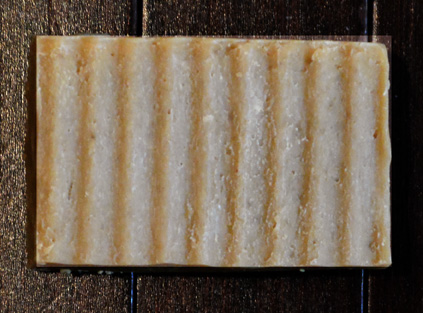
What Would I Do?

If I were going to make pine tar soap again, I would use an ounce or more of fragrance per pound of oils, and I would choose something strong.
Fragrances and Essential Oils for Gift Soaps
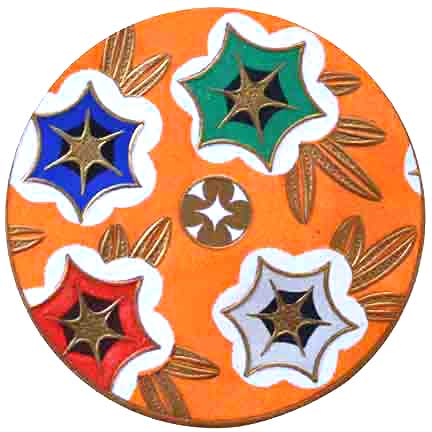
Unless you know someone's taste in fragrance, it's best to pick something that almost everyone likes. Based on vendors' lists of bestselling scents, here are a few suggestions.
Essential Oils
Lavender
Mint
Lemongrass
Fragrance Oils
Lemon
Vanilla
Almond
Mixed herbs
Oatmeal, milk, and honey
Holiday fragrances
Holiday Fragrance Oils
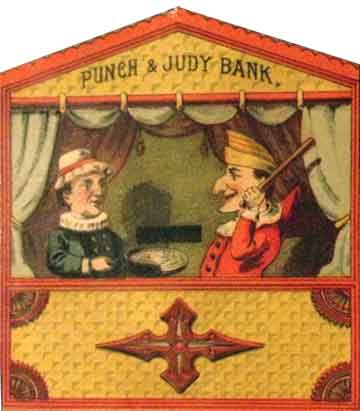
Every year brings a new crop of fragrance oils for the holidays. Some are evergreen fragrances, others are based on traditional holiday foods. The evergreen types can be especially welcome as a home fragrance if your Christmas tree is artificial. (See the discussion of home fragrancing, below.)
I'm more wary of most of the food ones. Of course it's a matter of taste, but most "cranberry" fragrances smell like red lollipops to me. Others, billed as eggnog, chestnut, or other holiday desserts, seem more akin to baby powder or floral.
"Snow" fragrances usually remind me of laundry detergent.
Chocolate, vanilla, and cinnamon are usually good choices, and mixed fruit and spice can work well, too. Many of these fragrances will turn the soap dark brown—so if that matters to you, ask the vendor if the fragrance discolors.
Gift Soap in a Hurry
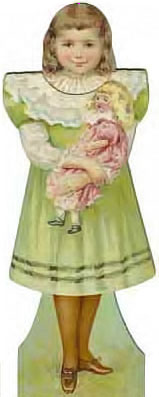
Melt and Pour
There are excellent brands of melt and pour soap base, but I've never seen the good ones for sale in a craft store. I wouldn't give craft store melt and pour soap as a gift—it has very low lather, so the soap will be disappointing. You might be able to boost that lather by adding sugar—it's worth an experiment, if you're really stuck. Or, if you're really pushed for a gift and want it to be soap, some of the online vendors with good soap base will do express shipping for an extra fee.
There's no curing time for melt and pour, so the soaps will be ready almost immediately.
CPOP
One problem with making soap gifts can be that there's not enough time left for the soap to cure. Hot process is one answer to that, and another is "cold process oven process," or CPOP. For CPOP, you make cold process soap in molds that can withstand higher temperatures. I've used wood, which is safe in this range, and also silicone.
Right after pouring the soap, cover the mold with an oven-proof lid—not aluminum foil—and put it in a warm oven. The temperature should be around 170°F (around 75°C) or even lower—in fact, as low as your oven control will permit. (Mine goes down to 100°F, and that works fine.) Leave for a couple of hours. Test the pH when the soap cools, and don't give it to anyone until the pH has dropped to 9 or 10. (In my own tests, the soap reached a good pH right away, and came out of the molds cleanly as soon as it cooled.)
Even when the pH is good, the soaps last longer if they're not used for a week or two. For that time, store them on edge in a warm, dry place—preferably on a rack—to help some of the water evaporate.
It's best to do CPOP with the soap in a block or log mold rather than in individual molds. Surfaces of CPOP soap may not be smooth, and with a log mold, you can trim off anything you don't like. Slice the soap as soon as it's firm enough—being divided into individual bars will help it dry.
Packaging Soaps for Gifts
There are so many ways to package soap as an attractive gift. Here are a few.
Fill a small basket with soap. Raffia makes a good basket filler, and you can create a finished appearance with clear basket wrap. All these things are easy to find at craft stores. Sometimes, you can find beautiful baskets at farmers markets or art fairs.
Package soaps in small cellophane or fabric bags or fabric boxes. Net bags sold for wedding favors are easy and attractive, and they increase the soap lather, too.
Package soaps with other toiletries such as bath crystals, lotion, or hand cream with the same fragrance.
Add accessories such as loofah or mesh soap saver pouches, wood or plastic soap savers, a handknit washcloth, or a new or vintage soap dish. Nut, candy, and trinket dishes also make good soap dishes, combined with a soap saver.
Make your own labels using clip art.
Use your imagination to complement your soaps with pretty packaging!
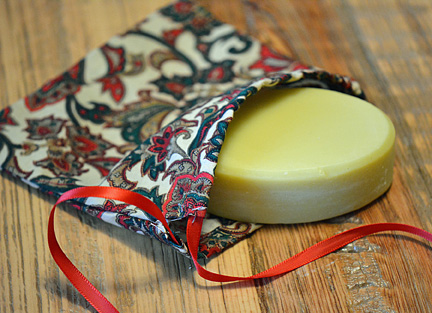
Juniper soap with fabric bag
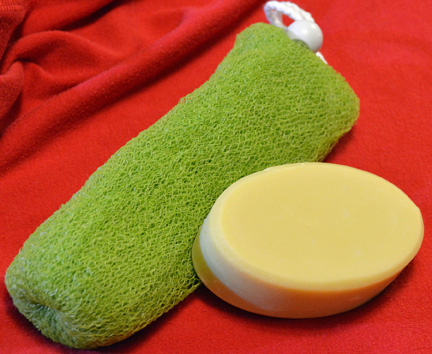
Soap with soap saver bag
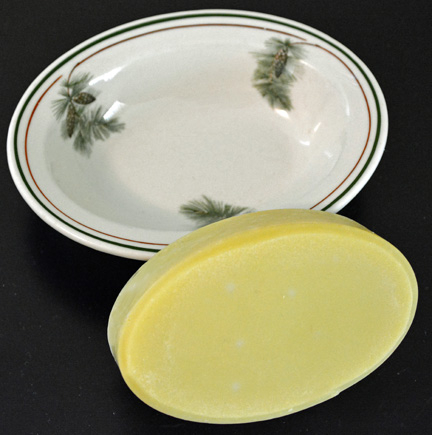
Soap paired with a collectible soap dish in a holiday theme
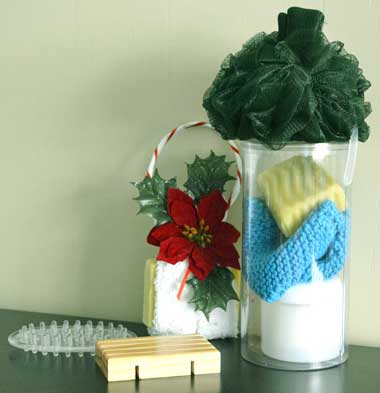
The photo shows, from left to right:
1. Two soap savers, plastic and wood. The plastic ones work better, but the wood ones are more attractive. I always give them with handcrafted soap, because it lasts much longer if a soap saver is used.
2. Bazaar item, a soap holder made by folding a washcloth from both sides toward the center, wrapping it around a bar of soap, securing it at the neck with a clear rubber band, and adding trim. Clear rubber bands are sold in drugstores and grocery stores, along with other hair ornaments and bands.
3. Container with a jar of cream, a handknit washcloth, a bar of soap, and a bath pouf. The clear tube is a reused container that originally held cable ties.
Giving a Soapmaking Lesson
If the gift recipient is someone who's interested in handmade soap, why not teach them how to make their own? Assemble a starter kit of supplies, tuck in a gift card for the lesson, and teach your friend how it's done. It's an unforgettable gift.
Shaving Soap
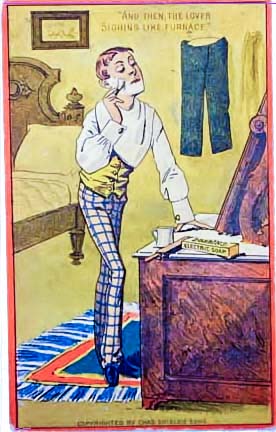
Fans of shaving with handmade shaving soap say they get a smoother, longer-lasting shave. Shaving soap makes a unique gift, and you can easily find shaving mugs and brushes to go with it. (Shaving brushes are made from badger or boar hair, or with synthetic bristles.)
Shaving soap can be made in bars or can be poured directly into mugs. Any mug will do, but mugs intended especially for shaving soap make the gift extra special. Bar soap can be cut into chunks before placing in a mug.
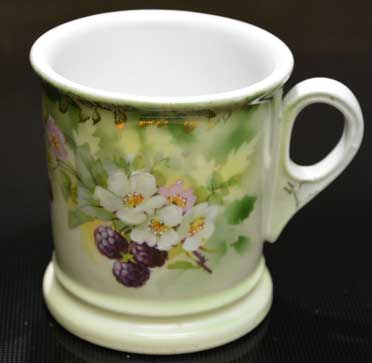
Vintage shaving mug
If you use beer for your liquid, you MUST remove the carbonation. To flatten beer, pour it into a shallow container to expose maximum surface area. Let it sit at room temperature for a day. Whipping it with a whisk may speed things up. Carbonation may also be removed by adding a pinch of baking powder, salt, sugar, or almost any other granular substance you're willing to have in your soap. The liquid will foam up vigorously, then go flat.
Bentonite clay provides slip for the razor, so it's very common to include it in shaving soap.
If your mug can stand heat, you can CPOP the soap right in the mug.
If you make shaving soap for someone who hasn't tried it before, there are great videos they can view online about how to use a shaving mug and brush for the best lather and skin conditioning.
Deluxe Shaving Soap
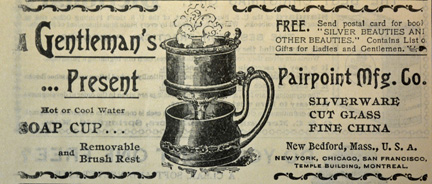
10.5 ounces (298 grams) almond oil
5 ounces (142 grams) wheat germ oil
1.5 ounces (43 grams) castor oil
1.5 ounces (43 grams) aloe vera extract
10 ounces (284 grams) shea butter
1.5 ounces (43 grams) hemp butter
1½ tablespoons bentonite clay
Optional fragrance (See note.)
9 ounces (255 grams) water, milk, or beer
2 teaspoons sugar
3.8 ounces (108 grams) lye
1. Prepare the liquid by mixing water, milk, or flattened beer with sugar. Freeze in cubes.
2. Melt solid fats and combine with liquid fats, aloe vera extract, and bentonite clay.
3. Combine frozen liquid with lye. When liquid is thawed and lye is dissolved, pour through sieve into fats. Stir or stick blend to trace.
4. Pour into mugs or other molds. If you use mugs, don't fill to the brim—leave about an inch at the top for developing lather with the brush.
Note: Since shaving soap is used on the face, I recommend using less scent than you might for hand soap. Normally, I'd use up to two ounces of FO or EO in a batch this size, depending on the vendor's recommendation. For shaving soap, I'd use no more than half that. Many users prefer an unscented soap for shaving.
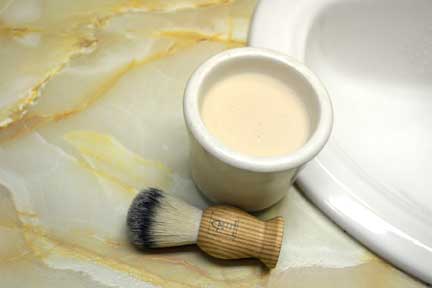
Simpler Shaving Soap
Use any soap recipe that has good creamy and bubbly lather—you need both. For each pound of oils, add one teaspoon of sugar and, if you can, two teaspoons of bentonite clay.
Home Fragrancing
Since you already have supplies for adding scents to soap, why not do something more with them—and try other fragrancing ideas as well?
Holidays are enhanced by indoor scents—the smell of cooking, as well as traditional pine, orange, and spice scents. There are many ways you can add to them!
Also, if you have an artificial Christmas tree, you'll probably miss the scent of a natural one. You can buy ornaments that include scent, but why not make your own?
Potpourri
Dry—Making your own dry potpourri from scratch is a real art, and you need access to large amounts of fresh flowers. You also need a fragrance fixative, such as orris root. I've bought top quality lavender buds and left them in bowls with no fixative. The scent faded much too quickly, even when I "refreshed" the buds with lavender essential oil.
Simmering—You can make simmering potpourri from flowers, spices, or fruit. If it's on the stove, it has to be monitored well, or you risk it boiling dry. An electric mini slow cooker is probably safer, though you do have to pay attention to those as well. I experimented with a mixture of pumpkin pie spice, culinary orange oil, and hot water, with good results. The scent worked its way slowly through the house, and was mild and pleasant. I refreshed the hot water from time to time and scraped down the sides of the crock.
Antique potpourri bowls are often shallow and wide, which maximizes the surface area of the contents. They usually have tops, and sometimes a stirring tool as well. Some are elaborate urns—now very valuable antiques.
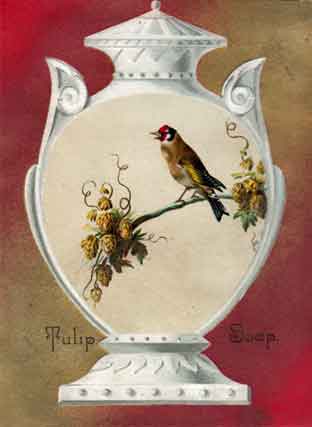
Reed Diffusers
In my experience, these provide scent to only a small area. The reeds have to be turned every few days, or they dry out and stop diffusing. Eventually, they dry up altogether, but you can get new ones without buying more scent. Some recipes call for diluting the fragrance oil with mineral oil or glycerine. Since both are more viscous than fragrance oils and essential oils, I don't see any reason to believe that would help.
Electric Warmers
There are electric potpourri warmers, as well as devices for melting scented wax pastilles. Almost any warmer that can be used safely would be effective. For example, I've seen recipes for half-pint mason jars filled with fragrant mixtures and placed on a mug warmer. Whatever you use, do it in accordance with manufacturer's directions and monitor for safety.
Candles
I don't make candles, and I've found that most scented candles I've tried don't really give much scent. There are exceptions, but I've had difficulty finding anything I like. Candles that seem quite fragrant in the store just don't burn with enough fragrance to make a difference. Others say that scented candles irritate their eyes.
Terrycloth
Cotton terrycloth—the old kind, not the velvety kind—consists of hundreds of tiny wicks. It diffuses scents very well. I use it for fragrancing in the bathroom and kitchen. Just put a few dabs of essential oil or fragrance oil on a cotton terry washcloth or bar mop towel and hang it over a towel rod. The scent doesn't carry far, but it's quite enough for a small room and lasts for days.
A pillow or other decorative object made of terrycloth could work in other rooms. For instance, a friend made a small pillow for me out of a holiday fingertip towel. If I set it under my Christmas tree with a dab of fir essential oil on it, it should scent the air around the artificial tree. A variation on this might be to make a patchwork tree skirt from heavy fabrics, including some terrycloth, and put the scent on those patches.
Choose a cloth color that won't show the discoloration of the oil.
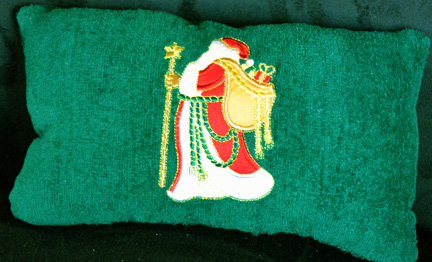
Terrycloth fragrance pillow
Tea Ball
You can make a scent diffuser with a mesh tea ball. Soak several cotton balls in essential oil or fragrance oil, put them in the tea ball, and hang where you like. I tried it with a very large tea ball, and it works fairly well. Whether this could be made to look decorative is another question. The mesh would have to remain open for it to work, so it may be more appropriate in a bathroom or closet than hanging in an entryway.
Air Freshener
You can make gel-type air fresheners with ordinary gelatin, water, fragrance, and salt. (The salt is supposed to prevent mold.)
Orange Pomander Ball
The orange is completely studded with whole cloves. The secret here seems to be to use an icepick to make the holes, rather than trying to push the cloves in with your fingers. Also to roll the finished pomander ball in orris root powder, and to keep it in orris root, rolling it daily, in a cool dry place for several days. Some crafters kept the pomander in the refrigerator for this step. And then, you hang it rather than let it sit in a bowl, which apparently promotes mold.
I found that a pomander works very well in a small space like a coat closet, but a single one isn't noticeable in an average-size room.
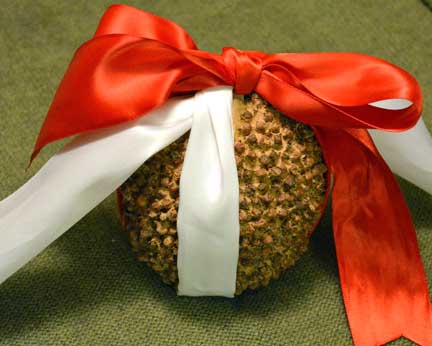
Orange pomander ball
Other Possibilities
I've come across far too many ideas to try. You'll find dozens if you put the words "home fragrancing" into your browser.





